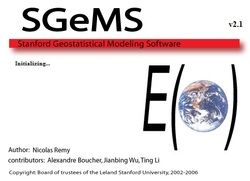SGeMS (Stanford Geostatistical Modeling Software)
SGeMS is a software developed at Stanford University that implements several geostatistics algorithms. It was written with two goals in mind. The first one, geared toward the end-user, is to provide a user-friendly software which offers a large range of geostatistics tools in a full 3D interactive environment. The second objective was to design a software that would cater to the needs of power-users through plugins and Python scripts
The Stanford Geostatistical Modeling Software (SGeMS) is an open-source computer package for solving problems involving spatially related variables. It provides geostatistics practitioners with a user-friendly interface, an interactive 3-D visualization and a wide selection of algorithms. With over 12000 downloads in less than 2 years.
This practical book provides a step-by-step guide to using SGeMS algorithms. It explains the underlying theory, demonstrates the implementation of the various algorithms, discusses their potential limitations, and helps the user make an informed decision about the choice of one algorithm over another. Users can complete complex tasks using the embedded scripting language, and new algorithms can be developed and integrated through the SGeMS plug-in mechanism.
SGeMS is the first software to provide algorithms for multiple-point statistics and the book presents an up-to-date discussion of the corresponding theory and applications. Incorporating a CD-ROM with the full SGeMS software, this book is an essential user-guide for professional practitioners of environmental, mining and petroleum engineering, as well as graduate students and researchers in fields such as remote sensing, geography, ecology, water resources, and hydrogeology and resources evaluation. Both beginners and more advanced users will find answers in the book on how to use the software and more generally about geostatistical practice.














